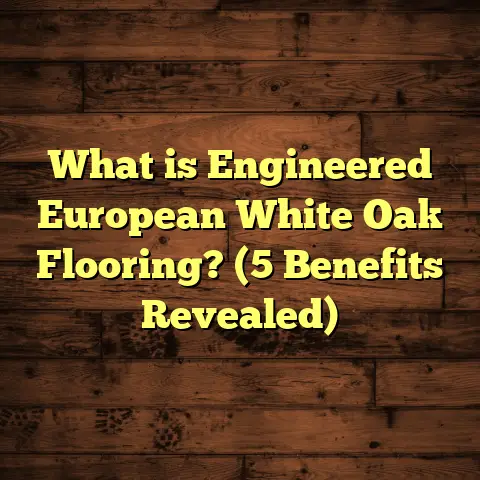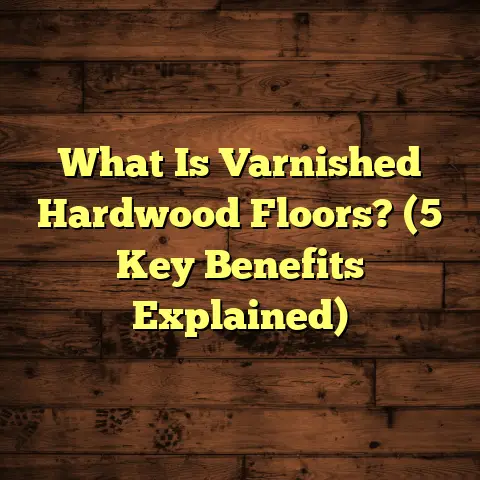What is Unfinished Hardwood Flooring? (5 Key Benefits Explained)
Trends in home flooring have shifted quite a bit over the years, with many homeowners leaning toward natural, authentic materials
that add warmth and character. Hardwood floors remain at the top of the list, but I’ve noticed a growing interest in something
less polished — unfinished hardwood flooring. It’s like going back to basics but with a modern twist. I want to share what I’ve
learned about this choice, especially since it’s been a game-changer in several of my projects.
What is Unfinished Hardwood Flooring?
Unfinished hardwood flooring is exactly what it sounds like: raw, natural wood planks that haven’t yet been sanded, stained, or sealed.
You get the wood as it comes from the mill, and the finishing touches happen after installation. This gives you the freedom to customize
the look right on-site.
Unlike prefinished hardwood, where the planks arrive ready to walk on, unfinished floors need to be installed first and then sanded
and finished in place. This means you can pick your stain color, sheen, and finish type to match your style perfectly.
I remember one project where the homeowner wanted a very specific shade that just wasn’t available in prefinished options. By choosing
unfinished flooring, we could experiment with stains right there in their home, ensuring the color complemented their existing decor flawlessly.
Comparing Unfinished and Prefinished Hardwood Flooring: My Take
When I started working with hardwood floors, I mostly installed prefinished ones because they were faster and less dusty. But over time,
I got curious about unfinished hardwood, especially after hearing from clients who wanted something more personalized.
Prefinished Hardwood
- Comes factory-finished.
- Faster installation (walk on immediately after).
- Less messy — no sanding dust.
- Limited stain/color options.
- Usually more expensive per square foot.
Unfinished Hardwood
- Installed raw, then sanded and finished on-site.
- More flexible with stain and finish choices.
- Takes longer due to finishing process.
- Can be messy because of sanding dust.
- Generally lower material cost but labor-intensive.
In my experience, unfinished hardwood allows for a truly custom floor that suits your space perfectly. However, if you want quick installation and less disruption, prefinished might be better.
Why Choose Unfinished Hardwood? 5 Benefits Explained
Let me walk you through five key benefits of unfinished hardwood that have made me recommend it to many clients—and why I keep going back to it myself.
1. Total Control Over Color and Finish
You might wonder how important this is until you’re stuck choosing from limited factory finishes that don’t quite fit your vision.
With unfinished wood, you get to decide everything: stain tone, gloss level, even distressing techniques.
On one job, the homeowner wanted a deep walnut stain but with a matte finish to reduce glare from their big windows. Prefinished options didn’t offer this combo without looking fake. We tested samples on-site and nailed the exact look after a few tries.
Data point: According to a survey by the National Wood Flooring Association (NWFA), 65% of homeowners who chose unfinished hardwood cited “customization” as their main reason.
How Customization Works in Practice
I’ve learned that many people underestimate how much lighting affects stain appearance. A color that looks rich and warm in a showroom can
look dull or too dark in a room flooded with natural light. The beauty of unfinished flooring is that you can test samples right where
the floor will be. You see the real interaction of light with your wood choice.
Besides stain color, you can also select different finishes: satin for a soft glow, semi-gloss for a bit of shine, or matte for that natural wood feel. Some finishes include additional protective qualities like water resistance or scratch resistance.
You can even combine finishes! For example, a low-gloss finish on most of the floor but semi-gloss in high-traffic areas for durability.
2. Seamless Floor Surface Without Visible Seams
Prefinished planks often have beveled edges to avoid chipping during transport. While this helps protect the floor, it creates visible grooves between boards after installation.
With unfinished flooring, once sanded smooth on-site, the surface is flush and continuous. This creates a cleaner look that many people find more elegant.
From what I’ve seen and heard from clients, this smoothness adds to the floor’s perceived value and longevity because dirt and debris have fewer places to hide.
Why Seamlessness Matters
Have you ever noticed how grooves between planks collect dust and grime? Even with regular cleaning, these tiny gaps can become dirt traps
over time. For families with kids or pets, this can be frustrating.
A seamless surface also means comfort underfoot — no sharp edges or ridges that might catch socks or snag heels.
I once worked with a client who had mobility challenges; they appreciated that their seamless unfinished hardwood floor made moving around easier without tripping hazards.
3. Durability Tailored to Your Environment
Because the finish is applied after installation, you can pick coatings that suit your lifestyle. For example:
- High-traffic areas might need a tougher polyurethane finish.
- Homes with pets may benefit from scratch-resistant coatings.
- Eco-conscious homeowners can choose low-VOC or water-based finishes.
I once worked with a family who had two large dogs. We selected a commercial-grade finish designed for high durability — something unavailable in prefinished products — and their floor held up beautifully for years.
Finishes That Fit Your Needs
There’s a wide range of finishes available for unfinished hardwood:
- Oil-Based Polyurethane: Durable but emits strong fumes during application.
- Water-Based Polyurethane: Lower odor and faster drying but sometimes less durable.
- Hard Wax Oils: Natural look with moderate protection; easier to spot repair.
- Aluminum Oxide (for prefinished only): Highly durable factory applied finish.
Choosing the right finish means balancing durability, appearance, and environmental concerns.
4. Lower Material Costs
Unfinished hardwood generally costs less per square foot than prefinished because it skips the factory finishing process. While labor for sanding and finishing adds time and cost, many clients find material savings worth it.
Here’s a rough breakdown from recent projects:
| Flooring Type | Material Cost (per sq ft) | Labor & Finishing Cost (per sq ft) | Total Cost (per sq ft) |
|---|---|---|---|
| Prefinished Hardwood | $6 – $9 | $3 – $5 | $9 – $14 |
| Unfinished Hardwood | $4 – $7 | $5 – $7 | $9 – $14 |
As you can see, total costs can be similar depending on labor rates. But if you’re willing to DIY some finishing steps or live in an area with affordable labor, unfinished wood is definitely budget-friendly.
How to Save Even More
If you’re handy or want to save money, you can do part of the finishing yourself. For example:
- Hiring pros for installation only.
- Renting sanding equipment.
- Applying stain or finish on your own schedule.
A homeowner I worked with took this approach—he installed the raw floor himself over one weekend and had professionals come back later for sanding and finishing. This split approach lowered his costs without sacrificing quality.
5. Repairing and Refinishing Made Easier
Hardwood floors get worn down over time — that’s just part of their charm. The good news with unfinished flooring is you have more options when it comes to repairs.
Because you finish them yourself (or hire someone who understands your preferences), refinishing later is straightforward. Prefinished floors are factory-lacquered and require special equipment or professional help to refinish without damaging the surface.
One client called me after 10 years because their unfinished floor had some scratches in high-traffic spots. A quick sand and reapplication of finish restored its original beauty without replacing boards.
Longevity Through Refinishing
Most hardwood floors last decades if properly maintained. Unfinished hardwood’s advantage is that when wear shows up—scratches, dullness—you can sand down the surface again to reveal fresh wood underneath.
Prefinished floors often have a thinner finish layer due to factory application limits which means fewer times they can be refinished before needing board replacement.
In fact, data from NWFA shows unfinished hardwood floors can be refinished up to 5–7 times over their lifespan compared to about 2–3 times for prefinished floors.
Diving Deeper: The Installation Process I’ve Experienced Firsthand
Understanding how unfinished hardwood is installed gives better insight into why it behaves differently from prefinished flooring during its lifetime.
Step 1: Acclimating the Wood
Before installation begins, I always recommend acclimating unfinished wood planks in the home environment for at least 3–5 days. This helps prevent warping or gaps caused by moisture differences after installation.
Step 2: Installation of Raw Planks
Unfinished hardwood typically comes as solid wood boards that are nailed or glued down over subflooring. Because they aren’t finished yet, care must be taken during installation to avoid dents or scratches since any damage will be visible post-finishing.
Step 3: Sanding After Installation
Once installed, sanding begins using heavy-duty drum sanders followed by finer grit paper for smoothness. This step creates an even surface free of imperfections.
This sanding process creates quite a bit of dust — which is why professionals use dust containment systems during this phase.
Step 4: Staining (Optional)
After sanding comes staining if desired. This is your chance to pick an exact color tone by applying stain directly onto the raw wood floor. Multiple coats may be needed depending on desired depth of color.
Step 5: Applying Finish Coats
Finally, several coats of protective finish are applied with drying time in between layers. These finishes protect against moisture and scratches while enhancing wood beauty.
Personal Stories That Highlight These Benefits
I want to share a couple of stories from jobs I worked on that really underline why unfinished hardwood made sense for my clients.
Story 1: The Custom Stain That Made All the Difference
I was installing floors for a couple renovating an old farmhouse. They wanted a rustic look but also something light enough to brighten their space.
After looking at several prefinished options that were either too dark or too yellowish, we decided on unfinished oak planks. We tried three different stains in their living room before settling on a soft grayish-brown that complimented their vintage furniture perfectly.
The process took longer but watching them fall in love with their floor was worth every extra day.
Story 2: A Durable Finish for Active Families
Another project was for a family with young kids and pets — a recipe for floor wear and tear. They chose unfinished maple flooring so we could apply a tough water-based polyurethane finish that resisted scratches and stains.
Two years later, their floors still looked fresh despite daily chaos. They told me they were glad they avoided prefinished floors that would have dulled or chipped much sooner.
Story 3: DIY Enthusiast’s Dream
A client who loved DIY projects purchased unfinished hardwood intending to install it themselves and apply their own finish over several weekends. They enjoyed picking out finishing colors and even learning how to use sanding equipment safely under my guidance.
Their enthusiasm paid off: they saved thousands on labor costs and created a truly personal flooring statement reflecting their hard work.
Additional Insights & Unique Data Points
Here are some lesser-known facts about unfinished hardwood flooring that surprised many homeowners:
- Environmental Impact: Because unfinished hardwood skips factory finishing processes involving solvents and chemicals, its environmental footprint is often lower compared to prefinished products.
- Wood Species Variety: Many mills offer more exotic wood species only as unfinished due to handling challenges during factory finishing—giving you access to unique flooring options if you choose unfinished.
- Moisture Adaptability: Unfinished floors allow final moisture adjustments during finishing which can improve long-term stability in humid or dry climates compared to prefinished floors sealed months earlier at the factory.
Tackling Common Questions I Get About Unfinished Hardwood Flooring
Q: How long does it take from installation to being able to walk on the floor?
A: Usually about 3–5 days due to installation, sanding, staining (optional), and drying times for finishes.
Q: Is sanding really messy?
A: Yes, sanding produces fine dust that spreads easily if not contained by professional equipment like HEPA filters or dust collectors.
Q: Can I do the finishing myself?
A: Definitely! But it requires patience and practice. I always recommend testing finishes on scrap wood first.
Q: How do unfinished floors perform in basements or humid areas?
A: Solid unfinished hardwood isn’t usually recommended below grade or areas prone to moisture unless special precautions are taken (like moisture barriers).
Maintenance Tips for Unfinished Hardwood Floors
Maintaining your unfinished hardwood floor ensures it looks great for years:
- Regular Cleaning: Sweep or vacuum frequently to remove grit that can scratch.
- Avoid Water: Use damp mop sparingly—water can damage wood.
- Protect High-Traffic Areas: Use rugs or runners where possible.
- Refinish When Needed: Light sanding and re-coating every few years prolongs life.
- Immediate Spill Cleanup: Prevent stains by wiping spills promptly.
Wrap-Up Thoughts From My Experience
Over years working with various flooring types and seeing what sticks around long-term in homes, unfinished hardwood has shown itself as one of my favorite choices when true customization matters most. It’s not always faster or simpler than prefinished options but offers flexibility many homeowners appreciate deeply once they understand what’s involved.
If you enjoy having control over every detail of your home’s style—or want floors that age gracefully while being repairable—unfinished hardwood flooring deserves serious thought.
What about you? Have you tried unfinished flooring or thought about it? What questions do you have? I’m here if you want to chat about making your flooring project as satisfying as possible!





